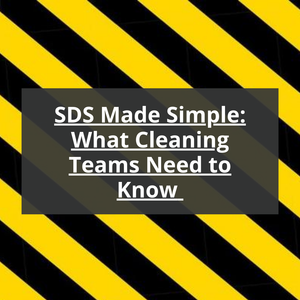Posted by Hygenol Cleaning Supplies on 5th Sep 2025
SDS Made Simple: What Cleaning Teams Need to Know (and Where to Find It Fast)
Whether you’re a cleaner, facilities manager, or health and safety officer, you’ve likely seen a Safety Data Sheet (SDS) before. But let’s be honest, most people don’t actually read them.
That’s a problem. The SDS holds essential information for using any chemical product safely, effectively, and legally.
In this guide, we’ll break down exactly what an SDS is, what each section means in plain English, and how Hygenol’s new QR code labels make it faster than ever to access them.
What Is a Safety Data Sheet?
A Safety Data Sheet (SDS) is a legally required document that explains the hazards, handling, storage, and disposal of a chemical product.
In the UK and EU, SDSs follow a strict 16-section format under REACH regulations. They’re essential for:
-
Workplace safety
-
COSHH compliance
-
Emergency response
-
Proper usage and storage
What’s in an SDS? (Explained Simply)
Here’s a plain English guide to what you’ll find in each section of a typical SDS:
1. Product and Company Identification
The product name, code, and who supplies it (e.g., Hygenol Cleaning Supplies Ltd).
2. Hazard Identification
Key risks and warning symbols (like corrosive, irritant, flammable).
3. Composition/Ingredients
What’s in the product and whether any ingredients are hazardous.
4. First Aid Measures
What to do if someone inhales, swallows, or gets the product on their skin or eyes.
5. Firefighting Measures
How to handle fires involving this product — including extinguishers to use.
6. Accidental Release Measures
What to do if the product spills or leaks.
7. Handling and Storage
Safe ways to use, transport, and store the product.
8. Exposure Controls / Personal Protection
Whether gloves, masks, or ventilation are needed during use.
9. Physical and Chemical Properties
Details like colour, smell, pH, boiling point, etc.
10–13. Stability, Reactivity, Toxicology, Ecological Info
How the product behaves, how dangerous it is, and its environmental impact.
14. Transport Information
If the product is regulated for shipping.
15. Regulatory Information
Which laws apply to this product.
16. Other Information
Any extra details, like full wording of hazard statements or date of issue.
Accessing SDS Instantly with Hygenol QR Labels
In the past, SDSs were often stored in dusty folders, buried in emails, or forgotten completely. That’s changed.
All Hygenol product labels now include a QR code that links directly to the SDS for that exact product.
Benefits:
-
Instant access on-site from any smartphone
-
No login or searching required
-
Always up to date
-
Perfect for quick training or audits
Who Should Be Reading SDSs?
-
Cleaning operatives – to understand safe usage and PPE
-
Supervisors – to create COSHH assessments
-
Health & Safety Officers – for legal compliance
-
Procurement teams – to assess product suitability
-
First aiders – to respond quickly to incidents
Final Thought: Make SDS Use Part of the Routine
An SDS isn’t just paperwork. It’s a tool.
With Hygenol’s QR labels, you don’t need to dig through files or guess what PPE is needed. The info is right there when and where you need it. Make sure to look out for updated labels across all Hygenol cleaning products.
Need help or want to learn more? Contact our team — we’re happy to help.

